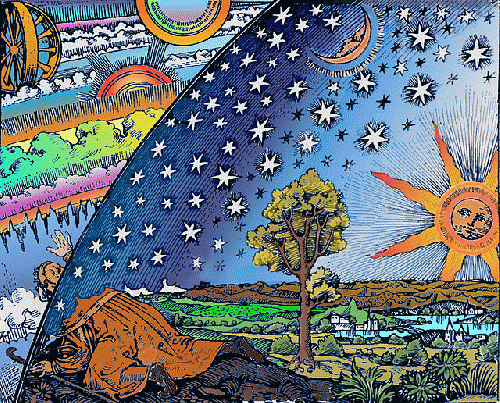And ain't it the truth babe?...
It's
down to me
Yes it is
The way she does just what she's told down to me
The change has come
She's under my thumb
Ah, ah, say it's alright
The Rolling Stones (Jagger and Richards)

Flammarion Woodcut 1888 Color 2
(Image by (From Wikimedia) Unknown author, Author: Unknown author) Details Source DMCA
How can the people of the Earth make this "great transition" by coming together in common effort while respecting and honoring our diverse cultures and traditions? One important way is to recognize that, as a species and despite our many differences, we have been on a common journey.
To accomplish this goal, a key element in examining present predicament involves some of the ways in which we have experienced ourselves as "divided". A core aspect involves understanding the background of authoritarianism as a millennia-long mode of organizing society.
Social scientist Riane Eisler clearly conveys her belief that the greatest obstacle to humanity's survival is the "dominator" mode of social organization. This has also been termed by Philip Slater, the "mega-culture of authoritarianism," and we will take a brief look at a few of the ways this is currently manifesting in our world. Later, I will also be touching upon on a perspective, which imparts hope and the possibility of "the emergence of humanity."
Recent scientific approach in archaeology, new information about the history of civilization has come to light that clearly challenges the long-held assumption that civilization has always been based on the thought-form of ranking of one half of humanity over the other: the familiar domination of men over women, as well as man over nature, and men over other men. We are presented with mounting archeological evidence from a great many Neolithic cultural sites that proves humanity was capable of peaceful social organization and technological advances.
The crux of Eisler's message - that human potential is stunted in dominator societies that use force (and the threat of force) to maintain their rigid social hierarchies - is supported by ample evidence from numerous sources. The new alternative, a continuation of the interrupted ancient partnership model that emphasizes the linking of humanity in peaceful equality, starting with the most fundamental step of linking women with men, as opposed to the ranking of one half of humanity over the other, is presented as essential to our very survival as a species.
In a chapter entitled The Breakdown in Evolution - A Dominator Future, Eisler (1987) makes this extraordinarily important point:
"When the elected leaders fail to solve economic, social, and political problems, people look to others for answers. In the androcratic mind, valuing above all rank-orderings [and conditioned to equate right with might] these answers tend to be equated with violence and strong man rule. It has often been suggested that the great psychic appeal of a totalitarian future is its promise of a "strong leader" who like the "strong father" of childhood will "take care of things." Certainly, a mind socialized to submit to male authority will tend to turn to this "protection" in times of crisis. But there is another reason for the strong appeal and great danger of modern totalitarianism"What we may now see, through our repossession of our lost past, is that, in its methods of control and basic structure"Modern totalitarianism is the logical culmination of a cultural evolution based on the dominator model of social organization"be it rightist or leftist, Christian or Muslim, the totalitarian solution is nothing more or less than an updating of the androcratic solution."
We can see this on a daily basis in the ascendance and governing style of Donald Trump.
Eisler reminds the reader of the fact that - in all their various guises - totalitarian solutions continue to "make sense" to many people in our world. This is not, she argues, because such solutions offer any viable or realistic answers to the mounting problems of our times. The attraction, she maintains, lies in the entrenched power of androcratic and neo-androcratic symbols and myth.
(Note: You can view every article as one long page if you sign up as an Advocate Member, or higher).




